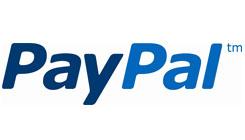 Updated: PayPal said that it will indeed lay off 325 employees.
Updated: PayPal said that it will indeed lay off 325 employees. Big change is afoot at payment service PayPal, which posted strong results for parent eBay last week. Revenues grew by 23 percent to $1.4 billion. It expects to complete more than $10 billion in mobile payments this year despite increasing competition from credit card companies, startups like
Square and established players like Google. As Bill Scott, senior director of user interface engineering, put it, “There seems to be a story about another mobile payments startup on TechCrunch every day.” PayPal is focused on returning to its days as a leaner, more nimble operation that innovates more rapidly.
(There have been rumors that up to 400 jobs will be cut in that streamlining.) On Monday, the company rolled out its first retail partnership, with AT&T, for its PayPal Here credit card reader, and announced a service that will allow users to put money in and take cash out of their PayPal account at select MoneyGram locations worldwide.
New Leadership
Scott came to PayPal about a year ago from Netflix with the mandate to “really up our game” in front-end engineering. He’s among the new leadership at the payment site, led by new President David Marcus, who in June began a makeover of the company by consolidating its nine product groups. The mix of veteran staff, with their perspective and history, and new employees are leading to real change, Scott says. “What I saw here [at PayPal] was that a lot of processes had been put into place for a lot of the right reasons -- for site stability, for security, to protect people’s money -- but perhaps it had skewed a little too far that way," Scott recalls. "It [was] taking a long time to get products up and out the door and [there were] a lot of waterfall and siloed approaches to software development.”
New Technology
Among the changes at PayPal has been a move to technology codenamed Sparta that allows it to operate more like a startup, allowing applications to be built in weeks instead of months. The engineering stack had been focused around XML and XSLT on the front end and C++ on the back end. The environment, while stable, didn't use the sexiest technologies, which made recruiting difficult. PayPal was using Java Server Pages, an area that had been a recruiting challenge for Scott at Netflix.
Lean UX and Agile Development
Soon after arriving, Marcus put together a small team from the engineering, product and design units that within a week had a new, but yet-to-be launched checkout process up and running and moving into usability tests. “That was our first encounter with using a lean UX methodology," Scott says. "That helped us move to a cycle where every week we were releasing to usability testing – we had real customers coming in, we were testing mobile, tablet and desktop, with a mobile-first mindset,” Scott said. “It completely revolutionized the way we thought about developing here." Now the company's moved on to reinventing its merchant on-boarding -- a source of complaints -- and projects such as recreating its APIs to improve the developer experience, and creating a simple service layer to smooth things out for internal developers. One new approach: “We’re getting rid of all the extraneous documentation … making the living prototype the actual spec," Scott says.
The Company-Wide Challenge
Now PayPal faces the task of scaling such new approaches for a company of 11,000 employees. That's the focus of an internal initiative that's looking at every aspect of the business, down to where employees sit. While the company prizes its collaborative spirit, it’s also tweaking that to gain speed. “We don’t want to lose niceness, but we have to make decisions quickly," Scott explains. "Get the key players, make a decision and move forward." But, he adds, "you don’t want to do it in kind of a bully fashion.” PayPal's also paying a lot of attention to customers, and getting their continual feedback. Besides making decisions about a product's features "a lot easier," Scott says it eliminates much of a team's politics and the need for a seemingly endless search for consensus.
No Fear
The crush of competition it crushes doesn't scare PayPal. In fact, Scott says the company relishes it. “We have all these great products that have been buried under, frankly, a less-than-stellar user experience," he says. "Now if you see our new PayPal.com, our PayPal Here (credit-card reader) – this new ethos that David put into place with design being front and center … we think we have all this magic.”
 Updated: PayPal said that it will indeed lay off 325 employees. Big change is afoot at payment service PayPal, which posted strong results for parent eBay last week. Revenues grew by 23 percent to $1.4 billion. It expects to complete more than $10 billion in mobile payments this year despite increasing competition from credit card companies, startups like Square and established players like Google. As Bill Scott, senior director of user interface engineering, put it, “There seems to be a story about another mobile payments startup on TechCrunch every day.” PayPal is focused on returning to its days as a leaner, more nimble operation that innovates more rapidly.
Updated: PayPal said that it will indeed lay off 325 employees. Big change is afoot at payment service PayPal, which posted strong results for parent eBay last week. Revenues grew by 23 percent to $1.4 billion. It expects to complete more than $10 billion in mobile payments this year despite increasing competition from credit card companies, startups like Square and established players like Google. As Bill Scott, senior director of user interface engineering, put it, “There seems to be a story about another mobile payments startup on TechCrunch every day.” PayPal is focused on returning to its days as a leaner, more nimble operation that innovates more rapidly.
 Updated: PayPal said that it will indeed lay off 325 employees. Big change is afoot at payment service PayPal, which posted strong results for parent eBay last week. Revenues grew by 23 percent to $1.4 billion. It expects to complete more than $10 billion in mobile payments this year despite increasing competition from credit card companies, startups like Square and established players like Google. As Bill Scott, senior director of user interface engineering, put it, “There seems to be a story about another mobile payments startup on TechCrunch every day.” PayPal is focused on returning to its days as a leaner, more nimble operation that innovates more rapidly.
Updated: PayPal said that it will indeed lay off 325 employees. Big change is afoot at payment service PayPal, which posted strong results for parent eBay last week. Revenues grew by 23 percent to $1.4 billion. It expects to complete more than $10 billion in mobile payments this year despite increasing competition from credit card companies, startups like Square and established players like Google. As Bill Scott, senior director of user interface engineering, put it, “There seems to be a story about another mobile payments startup on TechCrunch every day.” PayPal is focused on returning to its days as a leaner, more nimble operation that innovates more rapidly.



